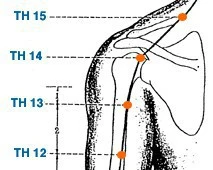Warm Acupuncture Found Beneficial for Chronic Lymphedema in Breast Cancer Patients
Cancer rates are on the rise globally, due in part to the fact that people are living longer, but there are also a multitude of risk factors in our modern times. For women, breast cancer is a serious risk accounting for nearly a quarter of all cancers. While breast cancer is often treatable with a combination of approaches, including acupuncture and Chinese herbal medicine, there are still a host of potential complications. Chronic lymphedema is one of the more common chronic complications that develops in roughly 40% of breast cancer patients (1). Proper management of lymphedema is crucial to the quality of life of cancer patients and cancer survivors.
Western treatment of lymphedema is largely a process of management to avoid pain, discomfort and further damage to the circulation in the affected area. There are a range of approaches from the western medicine side including lymphatic massage, elevation and compression, and a variety of medicines (diuretics, etc.) - among other more invasive options such as surgery. Early and mild cases can often be reversed and other more developed and stronger cases vary on their response.
From the Chinese Medicine side there are a variety of approaches using acupuncture, tuina (Chinese Medical Massage) and/or Chinese herbal medicine. These approaches vary depending on the case and the practitioner and are tailored directly to the needs and issues of the individual patient. One approach is acupuncture with moxibustion or "warm acupuncture" (see "What is Moxibustion?" if you are unfamiliar with the approach).
In the study that I'm discussing published in the "current oncology" journal, a team of researchers conducted a study comparing this "warm" acupuncture approach with diosmin which is a commonly used supplement that has shown benefit for lymphedema among other circulatory issues.
The team recruited 30 breast cancer patients with lymphedema and divided them into an acupuncture with moxibustion treatment group and a diosmin treatment group as a control. Within the treatment group 30 minute acupuncture treatments were offered every other day for 30 days. The following points and techniques were utilized:
 LI 10 - Generally used for pain and mobility issues in the shoulder, elbow, arm and wrist, also for more extensive issues such as paralysis.
LI 10 - Generally used for pain and mobility issues in the shoulder, elbow, arm and wrist, also for more extensive issues such as paralysis.- LI 11 - Expels wind and dampness from the LI channel in Chinese Medicine terms - pain and inflammation in the upper limbs and elbow, muscle atrophy, tremors, etc.
- LI 14 - Useful for pain in the shoulder and upper arm, weakness in the arms, muscle atrophy.
- LI 15 (with moxa) - Important points for shoulder issues including range of motion, pain - rotator cuff injuries, adhesive capsulitis, frozen shoulder, etc.
- TH 5 (with moxa) - Has immune system benefits, and also local uses for upper limb disorders including the elbow, forearm, wrist and hand.
- TH 14 (with moxa) - Lateral and posterior shoulder issues.
To gauge the effectiveness of treatment, researchers used a variety of measures including range of motion in the shoulder, quality of life measures (pain, function, etc.) and, of course, if there were any side effects from treatment.
The researchers found considerable improvement in the acupuncture with moxibustion group over the diosmin control group - 51.46% vs. 26.27%. They noted specific improvements at the areas of moxibustion which has potential clinical implications for driving better results with more extensive use of moxibustion. Further the researchers noted no adverse effects on the blood or the cardiovascular system from treatment.
All things considered this is a useful study and the noticeable affect that moxibustion had in specific areas should be noted by clinicians. In most cases the points used would be at least somewhat tailored including the use of "ashi" points (or points where it hurts upon palpation). Further, stronger clinical results would be obtained by working more broadly including points that aid immunity and the inflammatory functions in the body. This is clearly a valid option for treatment for chronic lympedema patients that should likely be used before more invasive options are attempted.
tag @yinyanghouse for questions/comments
Comment by Archived User
I have a query. To treat lymphedema, whether the acupuncture needle can be inserted in the affected arm or the other arm ? Because I have been advised not to treat the side which is surgically attempted !
Comment by Chad Dupuis
It depends. Generally speaking in areas with disrupted circulation (heavy bruising, open sores, edema, etc.) you want to avoid the area as there is a (albeit small in most cases) risk of infection. In this particular study they needled only the affected side. Whether or not this is appropriate would depend on each individual patient and the points chosen relative to their issues and current health status.
In most cases, personally, I worked bilaterally with a generally lighter/more conservative approach on the effected side and this seemed to work well over the years.